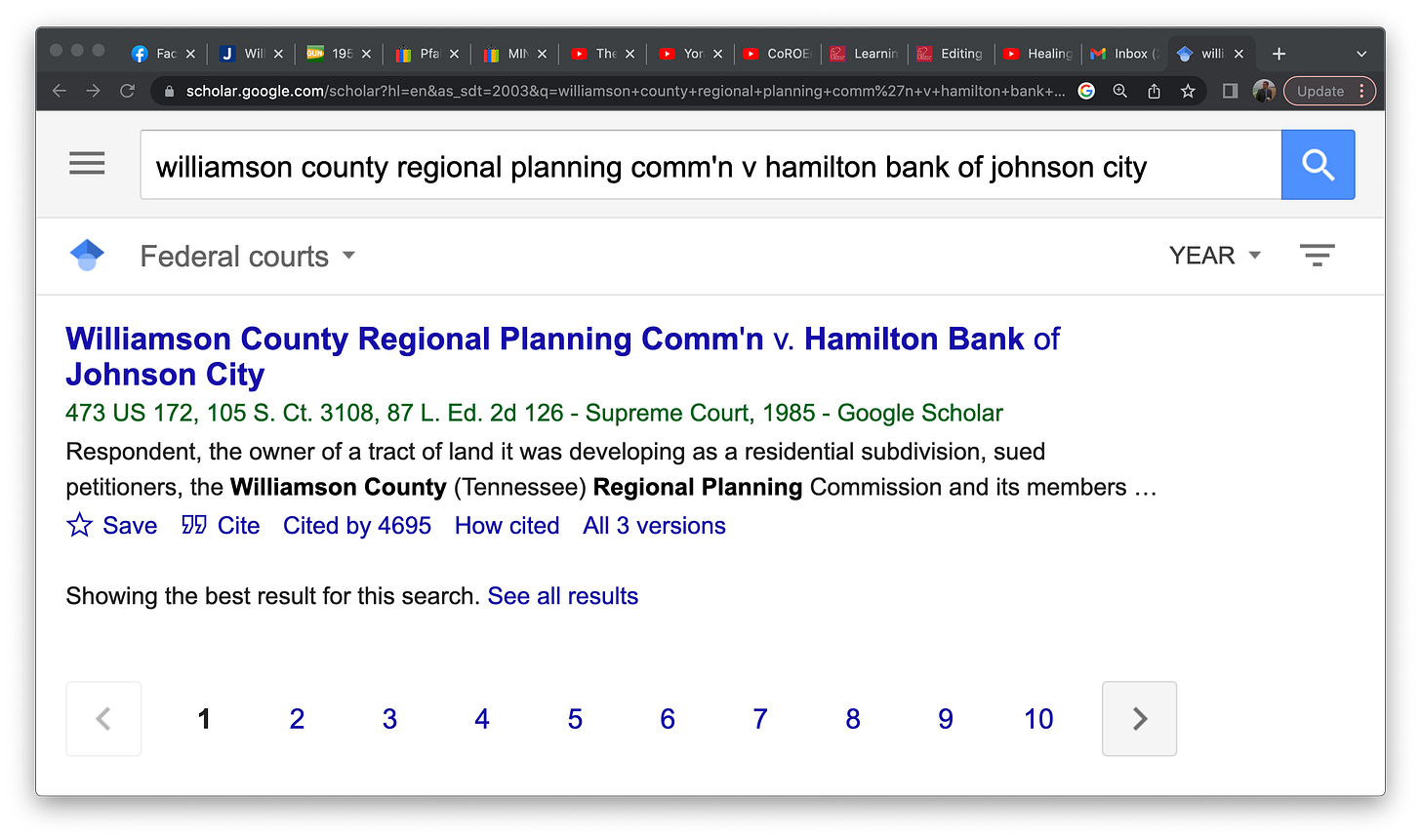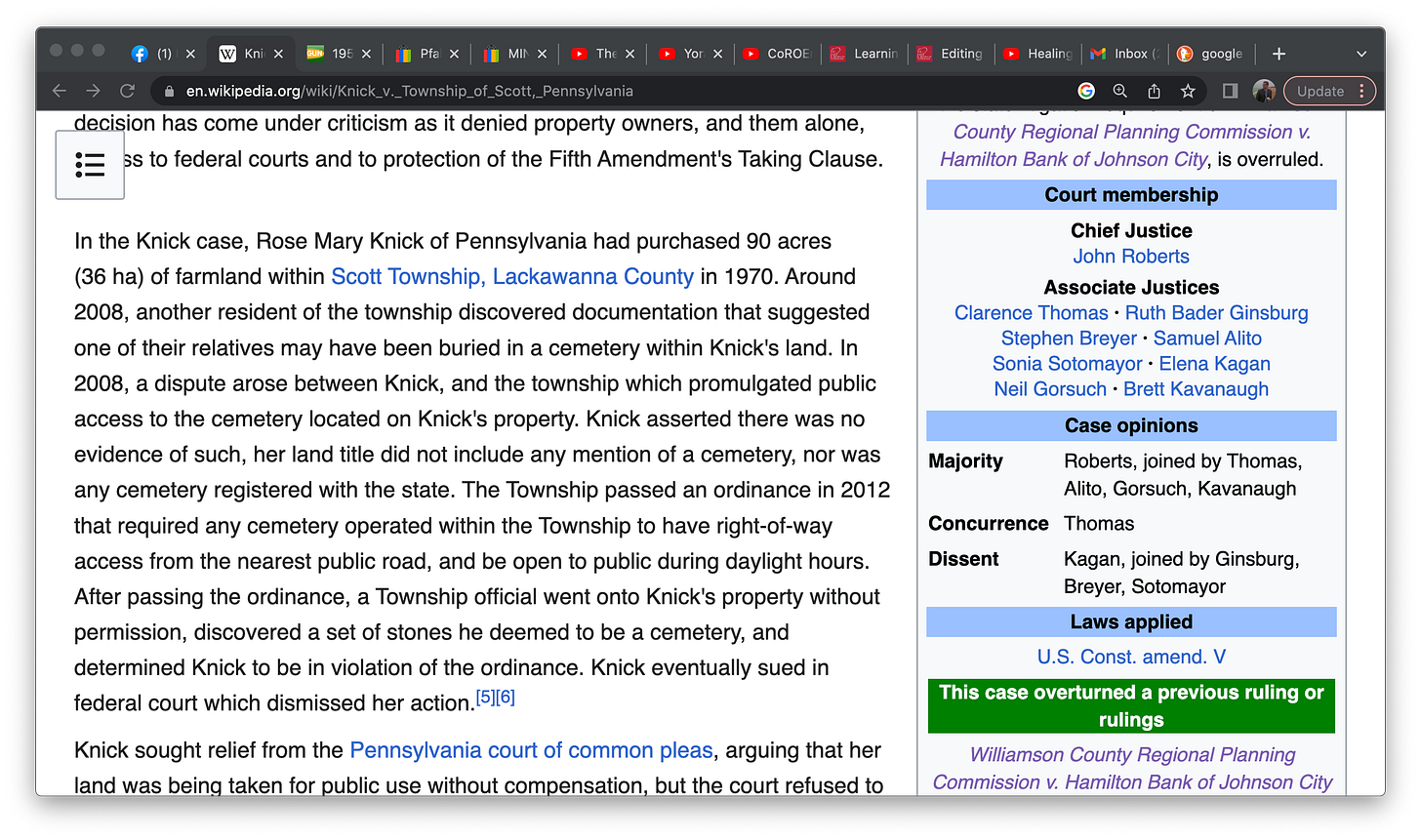Follow up to Learning Constitutional Law bit by bit as an Older Person : Intermediate
Describing versus Evaluating in American Politics
Yesterday’s post was a gentle introduction to begin learning some Constitutional Law bit by bit as an Older person. If you missed it, here it is :
Today, this is a gentle introduction to a distinction in Constitutional Law and American Politics: Description versus Evaluation.
Yesterday, we learned about a bad Supreme Court precedent from the 1980s. The case was called Williamson County Planning Commission v. Hamilton Bank of Johnson City (1985). It was referred to in that podcast I assigned yesterday from Season 2 of Stream of Conscience. Recall, it was the bad decision.
Now, at this point, we’re just describing the political aspects as they appear on the surface, or maybe just below the surface. We aren’t evaluating yet. To evaluate fairly, you’d have to read that decision and the dissent for yourself and see what you think. And that might feel a bit overwhelming. It might feel like you’re trying to learn to swim by being pushed into the deep end, and at the same time try to figure out what you think about swimming.
I’m not going to ask you to do that (yet). Maybe in the future. We’ll see how you do on this, first.
First, let’s find the case. Fortunately, we can use what has been called the “innernet”. I prefer to use books in a law library, but let’s not get too crazy.
Go to Google. If you don’t know how to get to Google, type into the search bar Duckduckgo.com, and hit enter. Then, in the search bar, type “google.” It’ll appear second in the search results.
It should look like this :
Okay. Now, click on the Google link. Then, type in Williamson County 1985. You should find some discussion or links to the case, like from Justia and Wikipedia. This will give you a baseline of information to find the text of the case to read for yourself if you want to later.
Now, we are going to use Google Scholar to find the text as it appears in the Law Library books. I have double checked this and I can assure you, what you find here online is the same thing in the actual, physical books on the shelf in the Law Library. Go to Google Scholar, type in Williamson County and click “case law.”
Next, click “federal courts” because this is a Supreme Court decision (of the United States, federal).
Now, click enter.
Since this is a big decision, Google will offer to fill in the rest for you. And if you know the date of the decision, or at least the year, you can hit enter and check to see if this matches. See “1985” down there in green ? We are on the right track.
So, click on that, and this is what you get.
This is the text of the opinion as it appears in the 473rd volume of Supreme Court Reporter book on the shelf in the Law School Library. The pagination will be page 172, as you can see. That’s the number up there on top. It reads 473 U.S. 172 (1985).
Let’s double check this information with the other original search results from Justia and Wikipedia.
Okay, there you go. It’s the same. Here’s the Wikipedia page.
It’s the same.
Now, the Wikipedia page is helpful here because it will tell you who was on the court at the time. And that’s the only thing we’re looking at today. Who voted what way. We are paying attention to Republicans versus Democrats on the Court. We’re just describing, here. We aren’t evaluating. We are just describing what happened. Very important.
How we doing so far ?
The majority includes both Republicans and Democrats, and the dissent was only one person, White, who, if you click on that link to his name, you’ll find out was appointed by JFK. In fact he was the only justice appointed by JFK. Byron White.
Sometimes I like to read the dissent first. Because that will be getting at the issue from someone telling you exactly what they disagreed with. It can be a faster way to find out what the heck the issue is. Go back to the Google Scholar page, search “dissent”, and you can find the text of why White didn’t like this bad decision from 1985.
Okay, but I’m not asking you to read the text of the opinions written by the justices on the court (yet).
Please take time to read this footnote, it’s very important as to what that “201” means in that last photo on the left.1
We have this bad case, and the Republicans and Democrats are responsible for it. Nixon appointees, Reagan appointees, LBJ, Eisenhower, Ford appointees are all agreeing with the outcome.
We have one, lone JFK appointee, Byron White, dissenting.2
Now, we don’t know their reasoning yet. We haven’t read it for ourselves yet. We aren’t evaluation the reasoning. We are just describing.
Recall from yesterday in that podcast episode I assigned, the wonderful ending point of that episode was the fact that in 2019 the Supreme Court overturned that bad 1985 Williamson County decision.
They overturned it , as you can see on the Wikipedia article, in Knick v. Township of Scott, Pennsylvania (2019). If you don’t recall that, go back to the episode from yesterday and skip to the last 5-10 minutes or so, and it’ll be there in all its glory.
Scroll down a little bit to find how out about how the vote differed between Republicans and Democrats:
What do you notice ?
It was Republicans and Democrats that caused the problem in 1985. But in 2019, who fixed it ?
It was Roberts, Thomas, Alito, Gorsuch, and Kavanaugh. A bare majority, 5-4, fixing this monstrosity from 1985.
All and only Republicans fixing it.
Again, I’ll say it again. We are not evaluating. We are only describing at this point.
Love,
Lucas J. Mather
As an aside, in the above photo, see “201” in the left margin ? That’s what page we would be on if this was the actual, physical book in the Law Library and you had it open on your lap while you drank your strong coffee out of your green, vintage Stanley thermos. And, it’s what page you would put in a footnote if you were referring or quoting this page for a paper in my class. Above that 201 is page 200, ending with the words “JUSTICE POWELL took no part in the decidion of this case.” Then you see *201 in the text, because that’s the end of page 200 in the actual, physical book (the kids say “literal” book), and if you scrolled up to the top it would take you back to page 172 (recall) where we started, is where it started in the 473rd volume of the book book, the kind with pages in it : 473 U.S. 172 (1985). Page numbering is very important for accountability. And yes, I have checked the actual, physical book in the Supreme Court Reporter series in the Hugh and Hazel Darling Law Library at Fowler Law School at Chapman University in Orange, California, with my strong coffee in my green vintage Stanley thermos and the book sitting heavily in my lap surrounded by freaked out, undergraduately grade-inflated students, and it is the same page as you see here. Just keeping you in the loop as to what “201” means up there. Above it is page 200, below it is page 201, and so on and so forth in either direction.
Byron White, the only dissent in this bad decision, was also one of only two dissents in Roe v. Wade. That’s interesting. That’s very interesting. Again, we are just describing. We’re just taking note. It’s not only Constitutional Law, it’s also American Politics.
Tuck that into your back pocket. Might come in handy later.
















